Designing for children? That doesn’t mean your home has to look like a daycare. So many parents want spaces that work for kids and still feel grown-up and stylish. You can pull off kid-friendly spaces that blend into your home’s overall design by choosing functional elements that keep things looking good.
Remember to repin your favorite images!
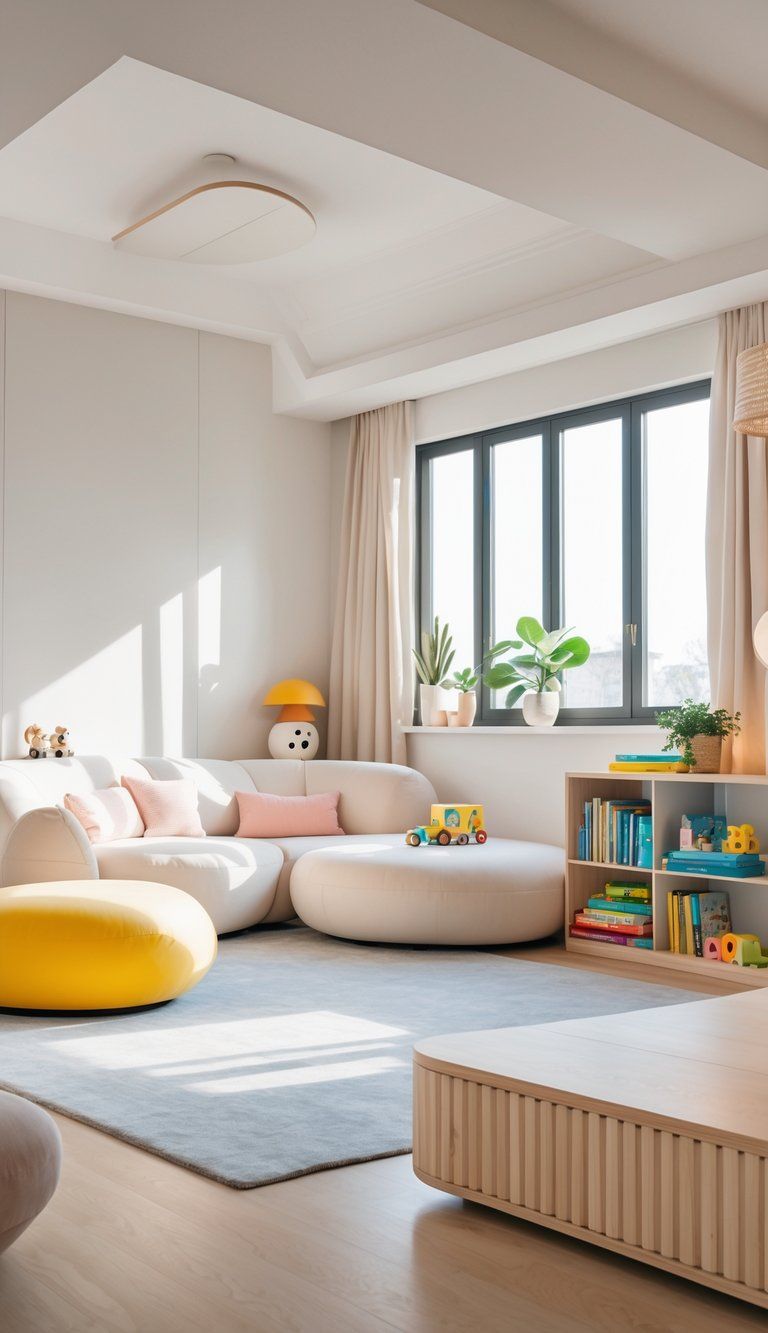
Try to think beyond cartoon characters and the usual primary colors when planning kids’ areas. For example, a jungle-themed bathroom with a leafy wall can create a playful environment that still feels a bit sophisticated.
Stores like IKEA actually offer a lot of affordable decor for kids’ spaces that still stick to clean, Scandinavian style. It’s surprising how well some of these pieces work.
Finding the balance between what works for your kids and what looks good to you is the trickiest part. Go for smart storage, sturdy materials, and furniture that can adapt as your child gets older. That way, your home works for everyone and doesn’t shout “children live here” to every guest who drops by.
Principles of Kid-Friendly Yet Sophisticated Design
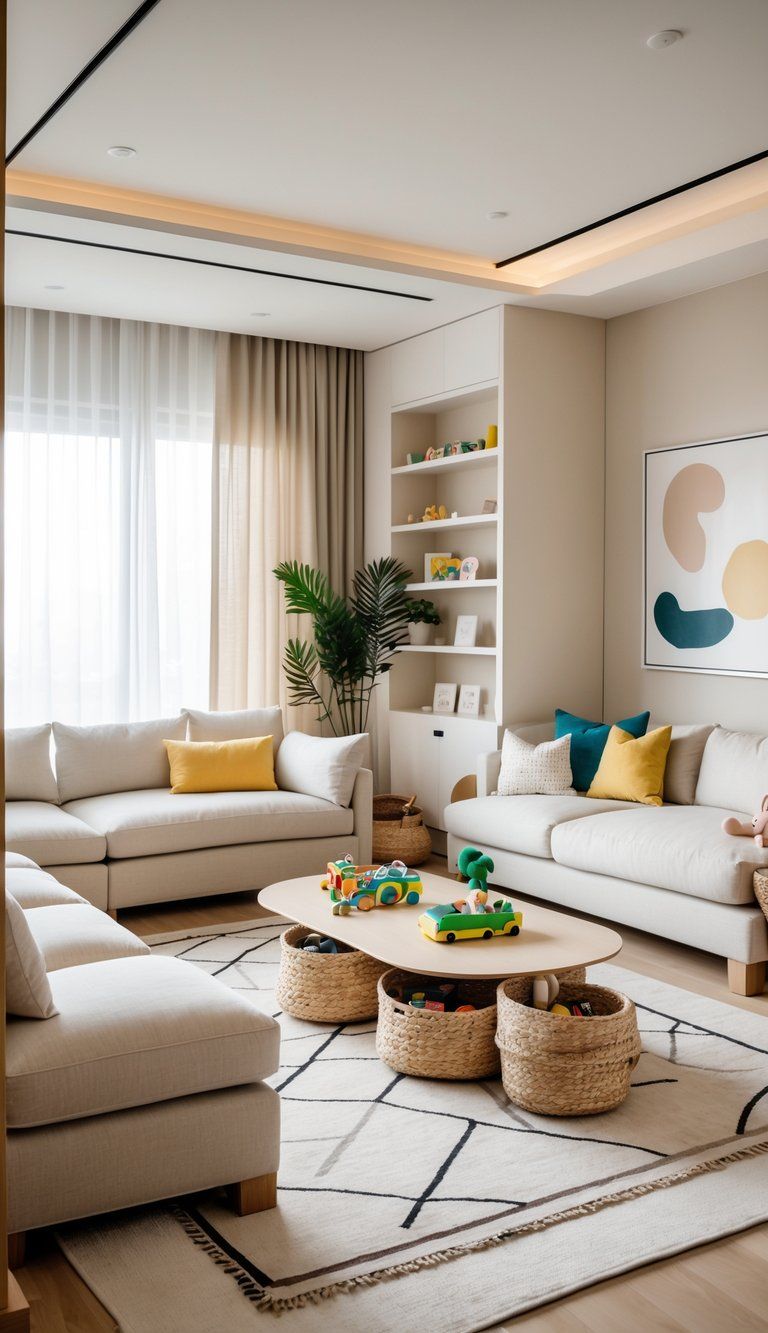
Creating spaces that work for both kids and adults means you have to balance playfulness and elegance. Good design should consider everyone in the home and still keep a cohesive aesthetic that feels like you.
Balancing Safety and Style
You don’t have to trade style for safety. Pick furniture with rounded corners and solid construction that still fits your vibe.
Coffee tables with curved edges look sharp (pun intended) and keep little ones safe.
Think about height, too. Wall-mounted shelves display your favorite things and keep breakables away from curious hands. Hidden storage, like ottoman benches with lids, lets you stash toys fast but still keeps them handy for the kids.
If you go for stain-resistant fabrics in nice textures, you can protect against spills without that obvious “kid-proof” look. Plenty of higher-end fabric brands now offer materials that resist stains but still feel great.
Choosing Versatile Materials
Choose materials that can hold up to daily chaos and still look good. Engineered hardwood or luxury vinyl flooring takes a beating from toy cars and spills, but keeps that upscale feel.
Some kid-friendly yet stylish material ideas:
- Performance fabrics (Crypton, Sunbrella)
- Washable slipcovers in natural fibers
- Indoor/outdoor rugs that are super easy to clean
- Quartz countertops (non-porous, resists stains)
- Matte-finish paint (easier to clean than glossy)
Pick furniture that gets better with age. A dining table with a distressed finish will forgive dings and scratches. Modular sofas can change shape as your family’s needs shift.
Prioritizing Function and Comfort
Create little zones for both adults and kids. A window seat with storage underneath can be a reading nook and a place to hide books and toys.
If you have a kitchen island, try one with different counter heights. That way, you can prep dinner while your child does homework.
Think about how everyone moves through the space. Open layouts let you keep an eye on the kids while you cook, but add area rugs to help with noise.
Lighting should be flexible. Dimmers add cozy light in the evening, but you’ll want bright task lighting for homework or crafts. Table lamps with heavier bases feel warm but won’t tip over easily.
Smart tech helps, too—motion-sensor nightlights guide little ones at night without messing up your home’s look.
Color Palettes That Appeal to All Ages
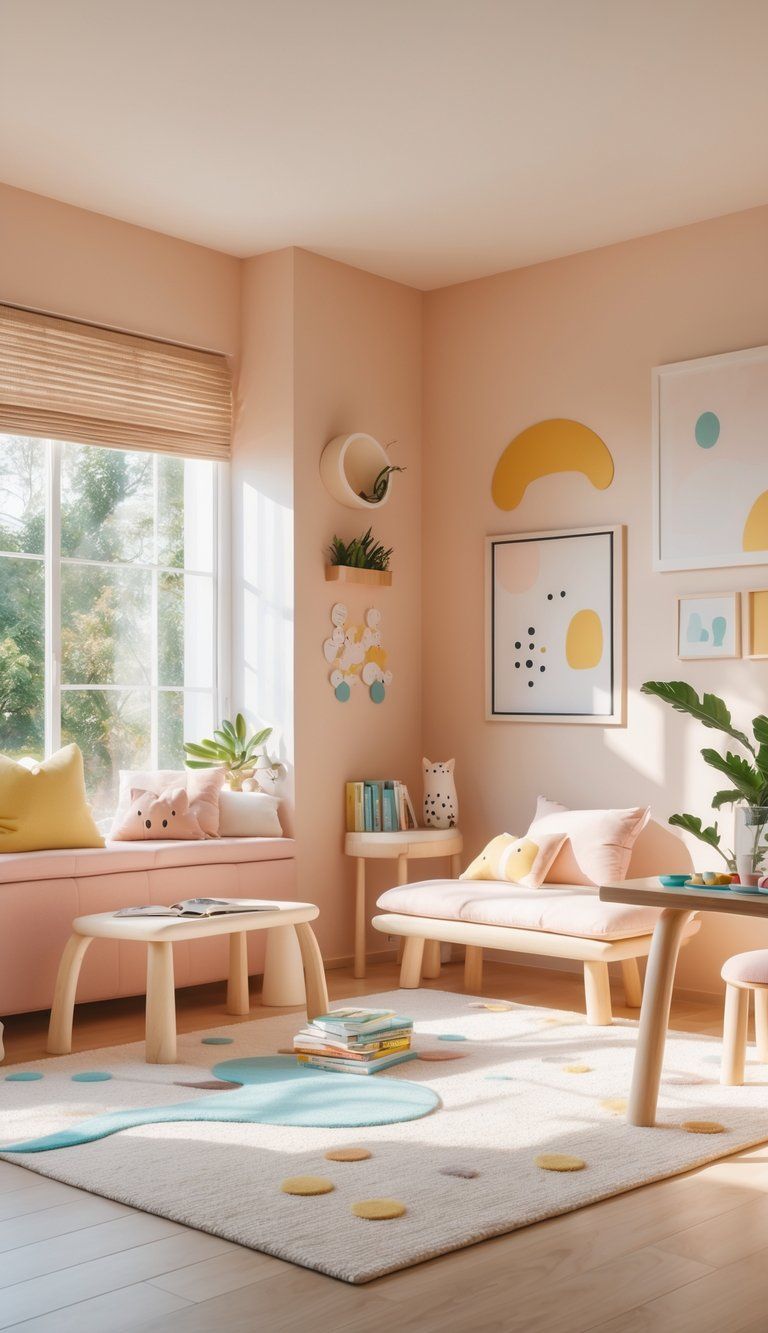
Getting the color palette right can help a space feel inviting to both kids and adults. A good color scheme creates harmony and keeps things interesting for everyone.
Using Neutral Foundations
Start with neutral colors as your base. Soft whites, warm beiges, gentle grays, and muted taupes last through every stage of childhood.
Neutrals work anywhere and let your furniture and decor pop. Some options to try:
- Warm whites like ivory or cream (less stark than bright white)
- Soft grays with a hint of blue or green
- Gentle taupes that feel warm but not stuffy
- Light sage green for a nature-inspired twist
Paint finish matters. Semi-gloss or satin holds up better in busy areas—much easier to wipe off those little fingerprints.
Incorporating Pops of Playful Color
Once you’ve got your neutral base, bring in color with accents. This way, you can swap things out when you want a change, without repainting everything.
Try:
- Colorful throw pillows and blankets
- Bright artwork (framed kids’ art actually looks great in simple frames)
- Fun rugs with patterns
- Colored storage bins or baskets
Don’t go overboard. Pick two or three accent colors that work together. Blues and greens calm things down, while yellows and oranges add a little energy.
You can still use bold colors that kids love—just stick to accents, not entire walls.
Avoiding Overly Juvenile Themes
A child’s space doesn’t have to shout “kids live here” to be fun and welcoming. Skip the character themes and go for design elements that last.
Try these ideas:
- Go for geometric patterns instead of cartoon prints
- Use nature themes (like a leafy wall) that don’t feel too young
- Try color blocking rather than murals
- Add textural elements that are interesting to touch and look at
Retailers like IKEA have plenty of playful pieces that can stick around as your child grows. Look for decor that can transition with them, so you don’t have to redecorate every year.
Furniture Selection for Multi-Purpose Spaces

Picking furniture for shared spaces means you have to balance style and practicality. The right pieces make rooms look grown-up but stay kid-friendly.
Opting for Timeless Pieces
Choose furniture with classic lines that won’t fall out of fashion. Round coffee tables with smooth edges help prevent bumps and still look elegant.
Modular sofas work wonders—they can be rearranged for family movie night or adult gatherings.
Ottomans pull triple duty as seats, footrests, and storage. Look for ones with removable tops to quickly hide toys before guests arrive.
Skip the trendy stuff that will date quickly. Invest in quality, simple designs that will last as your family grows.
Selecting Durable Yet Stylish Fabrics
The right fabric keeps your space looking great. Performance fabrics like Crypton and Sunbrella resist stains and fading but still feel soft.
Patterns and textured fabrics hide stains better than solid, light colors. Some top picks:
- Microfiber: Tough and easy to clean
- Leather or leatherette: Wipes down fast and ages well
- Indoor/outdoor fabrics: Plenty of stylish options now, not just for patios
Try out fabric samples at home and spill-test them with things like juice or markers.
Washable slipcovers are a lifesaver for sofas and chairs in busy spots.
Integrating Storage Solutions Seamlessly
Good storage keeps clutter under control and your home looking sharp. Go for furniture that does double duty.
Window seats with hidden storage stash toys but keep them within reach. Coffee tables with drawers or lift-tops hide games and art supplies.
Wall units that mix open and closed storage let you show off decor and hide the mess. Add some lower cabinets or drawers for easy kid access.
A few clever ideas:
- Side tables with hidden compartments
- Ottomans that open up for toy storage
- Credenzas with adjustable shelves
- Benches with baskets tucked underneath
The best storage doesn’t look like storage at all—guests might not even notice.
Decor Accents That Nod to Childhood Subtly
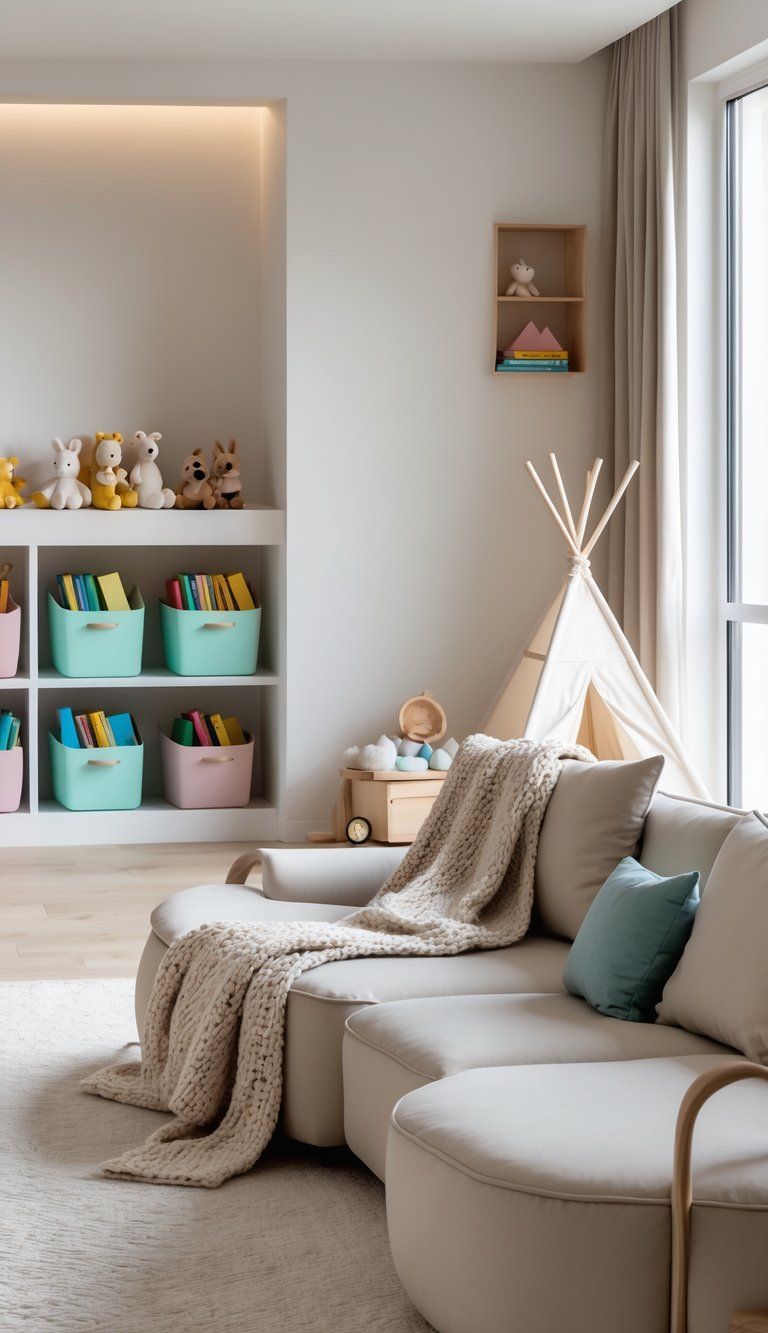
You can honor childhood in your decor without letting it take over. The right touches give a nod to your kids while keeping your home feeling grown-up.
Artwork Choices That Grow With Your Child
Pick art that works for all ages and can move from one stage to the next. Abstract paintings in playful colors catch kids’ eyes but still look at home in adult spaces.
Frame your child’s art in professional frames for a polished look that celebrates their creativity.
Museum prints of animals or nature scenes also work well. They appeal to kids and don’t make the room feel like a playroom.
Wall decals have come a long way—look for botanical or celestial themes that inspire imagination without looking childish. They’re easy to swap out as tastes change.
Quick Tip: Rotate displayed artwork with the seasons to keep things fresh and match your child’s interests.
Textiles and Accessories With Flexible Patterns
Bring in subtle patterns that hint at play without going overboard. Geometric prints, gentle stripes, or nature motifs work for everyone.
Choose textiles in sturdy fabrics with interesting textures. A throw with tiny stars or a cushion with woodland shapes can appeal to kids and still fit your style.
Storage can be fun and practical. Try:
- Woven baskets with a pop of color
- Bookends shaped like animals, but in grown-up colors
- Hooks or knobs with simple, playful shapes
Even big stores like IKEA have affordable decor that works for kids’ spaces without being over-the-top.
Organizational Strategies for Modern Family Living
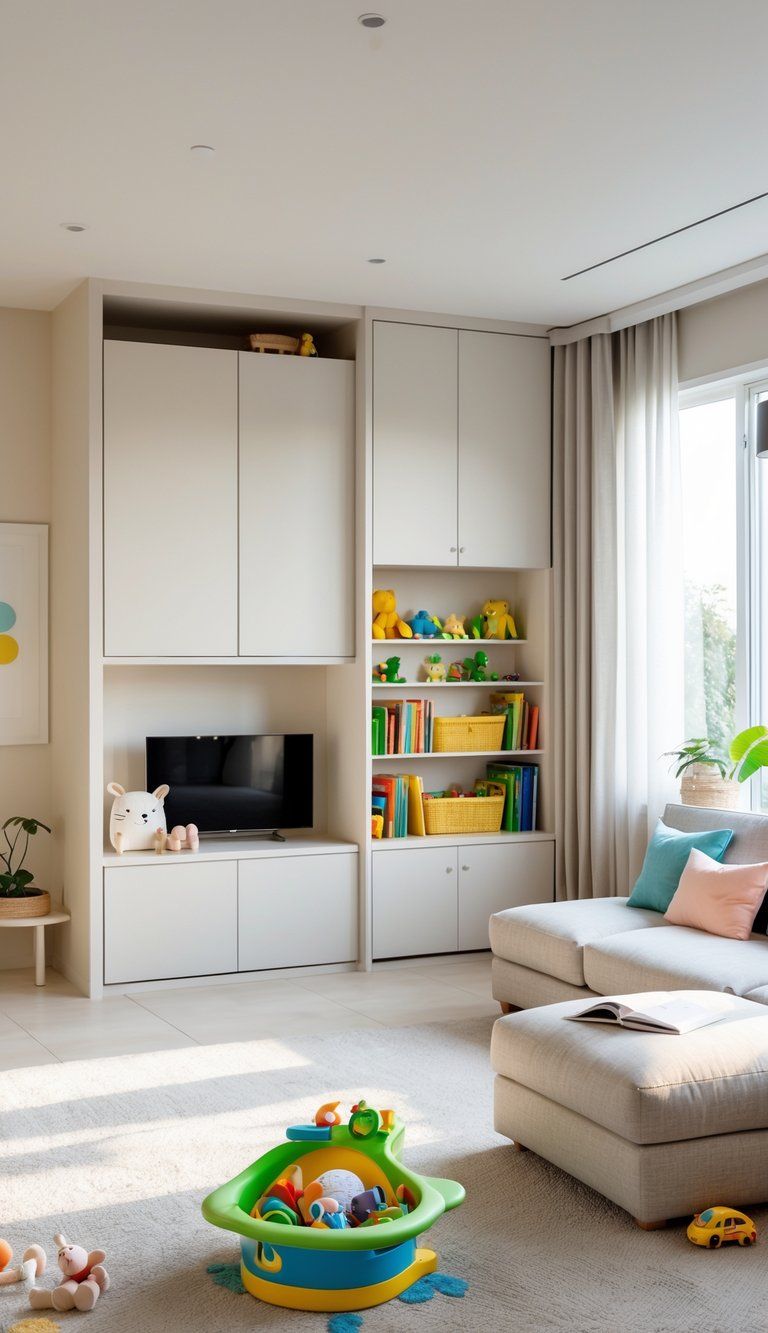
A well-organized home makes life easier for everyone. Smart storage and thoughtful layouts can turn chaos into calm, stylish spaces that work for the whole family.
Concealed Toy Storage Solutions
Built-in cabinets with drawers at kid height let children reach their things and make cleanup quick. Ottomans with storage double as seats and hide toys and games in a snap.
Decorative baskets and bins that match your style make tidying up less of a chore. Natural materials like seagrass or fabric containers in soft colors blend in better than bright plastic bins.
Wall-mounted storage frees up floor space. Floating shelves with decorative boxes or cabinets with doors keep kids’ stuff out of sight when you want things to look tidy.
Furniture with secret compartments is a game changer. Coffee tables with lift-tops or side tables with drawers let you stash art supplies or small toys without sacrificing style.
Creating Zones for Play and Relaxation
Set up different areas for activities by moving around your furniture and using simple visual hints. A little reading nook—just a bookshelf and some floor pillows—creates a dedicated space that keeps things cozy, not cluttered.
You can use open shelving units as room dividers to split up play zones from the rest of the living area, but still keep the space feeling open. These shelves pull double duty: stash toys on one side, display decor on the other.
Try multi-functional furniture that adapts to whatever you need. For example, a window seat with storage underneath works as a reading spot and tucks away toys when you’re done.
Area rugs help mark out play spaces without making anything permanent. Pick rugs that match your style—no need for cartoon prints if that’s not your thing.
Lighting can define zones, too. Table lamps in reading corners and adjustable lights in play areas draw invisible lines between spaces—no walls required.
Designing Shared Family Spaces
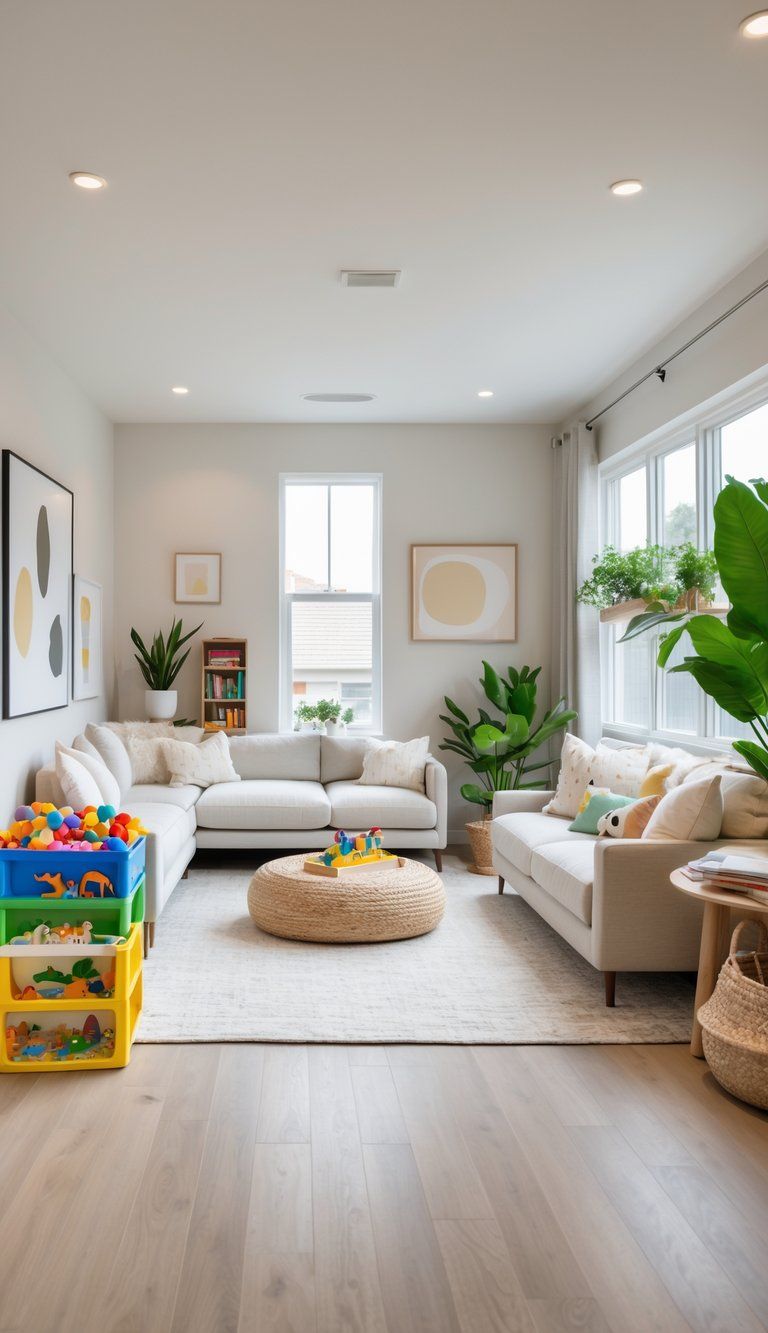
Making spaces that suit everyone at home means juggling function and style. The best family spaces do it all—without losing the look you love.
Open-Plan Room Layouts
Open-plan layouts really shine for families. You can watch the kids while you cook or work, which is honestly a relief. Instead of building walls, use furniture placement to carve out zones.
Low bookcases or console tables can act as dividers. They give you storage and keep sightlines open.
Area rugs also help separate activities. A washable rug under the dining table handles spills, while a softer one makes a perfect reading spot.
Go for storage with a purpose. An ottoman with hidden storage works as a seat, a footrest, and a quick place to toss toys when someone rings the doorbell.
Blending Adult and Child Aesthetic Elements
You really don’t need cartoon overload to make a space work for kids. Choose grown-up colors for big pieces like the sofa or walls, then sprinkle in fun accents.
Smart Material Choices:
- Stain-resistant, washable fabrics
- Rounded corners on furniture
- Scratch-proof surfaces
- Clever hidden storage
Mix grown-up art with framed kids’ creations. Matching frames pull everything together, so your gallery wall feels intentional, not messy.
Pick furniture that grows with your family. A dining table with leaves expands for parties, and multi-height seating means everyone fits at the table.
Lighting for Adaptable and Inviting Interiors
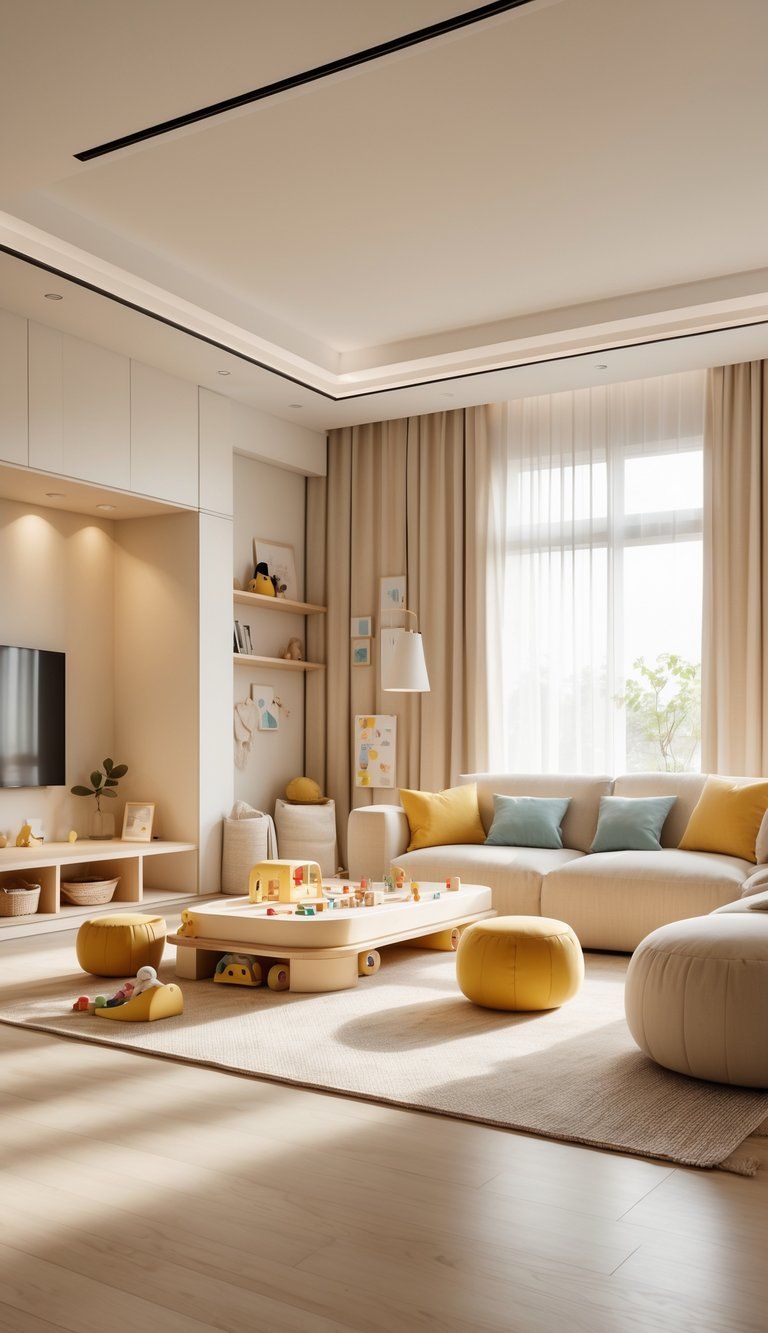
Lighting makes a huge difference, turning kid-friendly spaces into something a bit magical. The right choices let your rooms grow with your family, and you don’t have to give up on style.
Layered Lighting Techniques
When you layer lighting, your space gets a lot more flexible. Start with ambient lighting—think recessed ceiling lights with dimmers so you can set the mood.
Add task lighting for homework or crafts. Adjustable desk lamps with bendy arms let kids put light right where they want it. Wall-mounted reading lights by beds save space and make bedtime stories easier.
Accent lighting adds a little personality. Try:
- LED strips under shelves
- Picture lights to show off art
- Floor uplights for a subtle glow
Smart lighting systems let you set up different moods. You can have bright lights for playtime and soft light for winding down.
Child-Safe Lighting Options
Safety’s always top of mind with kids around. Use wall sconces with covered bulbs to keep little hands away from heat. Pick fixtures with rounded edges—no sharp corners, please.
Manage cords to avoid trips. Go for:
- Cordless, rechargeable lamps
- Wall-mounted lights
- Cord covers that blend in
Night lights help kids feel safe without messing up their sleep. Motion-activated options in halls and bathrooms turn on only when needed. Salt lamps cast a gentle glow, which is perfect for late-night bathroom trips.
LED lights stay cool and last longer than old-school bulbs. Many fixtures now have built-in LEDs—no more changing bulbs in hard-to-reach places.
Incorporating Personalized Elements Without Clutter
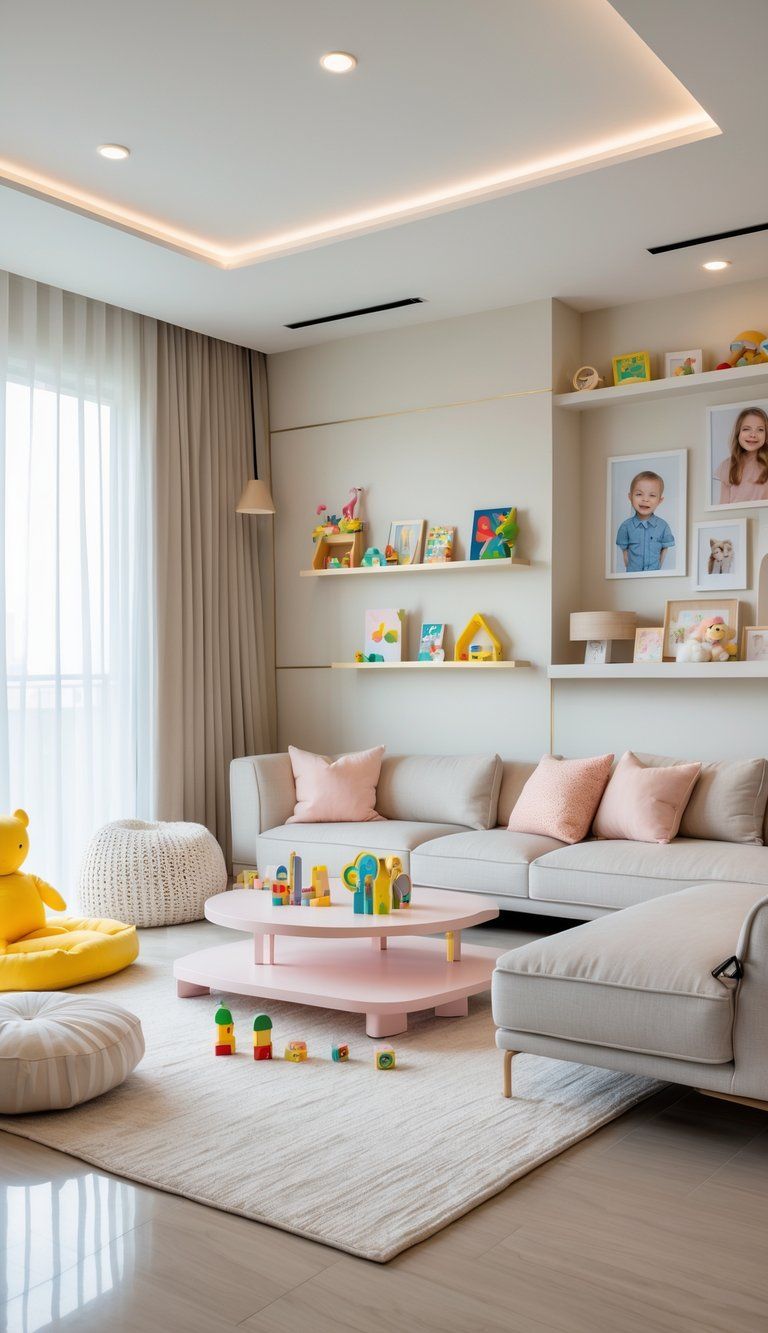
Bringing personal touches into kid-friendly spaces doesn’t have to mean chaos. The trick is picking meaningful things and displaying them with care, so your home stays calm but still feels like your family.
Rotating Displays for Kids’ Creations
Kids make a ton of art, don’t they? Instead of taping everything everywhere, try a rotating gallery.
Install a picture ledge to show off 3-5 current favorites. When new art comes in, help your child pick what to display and what to tuck away in a memory box.
Paint a small kitchen wall section with magnetic paint for a changeable display, no holes needed.
Digital options work, too. Apps like Artkive let you save photos of artwork, make digital albums, or even order custom books—memories stay safe, but clutter doesn’t take over.
Personalization With a Minimalist Touch
Little details can show personality without crowding your space. Here are some ideas:
- Custom throw pillows—just their initials or favorite color, not cartoon faces
- Framed silhouettes as understated art
- Photo displays using matching frames for a tidy look
Choose furniture with hidden personalization—maybe a pop of their favorite color inside a drawer. It’s a fun secret that doesn’t mess with your design.
Let kids pick one statement piece for their room—like a cool lamp or unique bookends—instead of going all-in on a theme. It teaches them about making thoughtful choices and keeps your home looking pulled together.
Future-Proofing Your Home’s Style
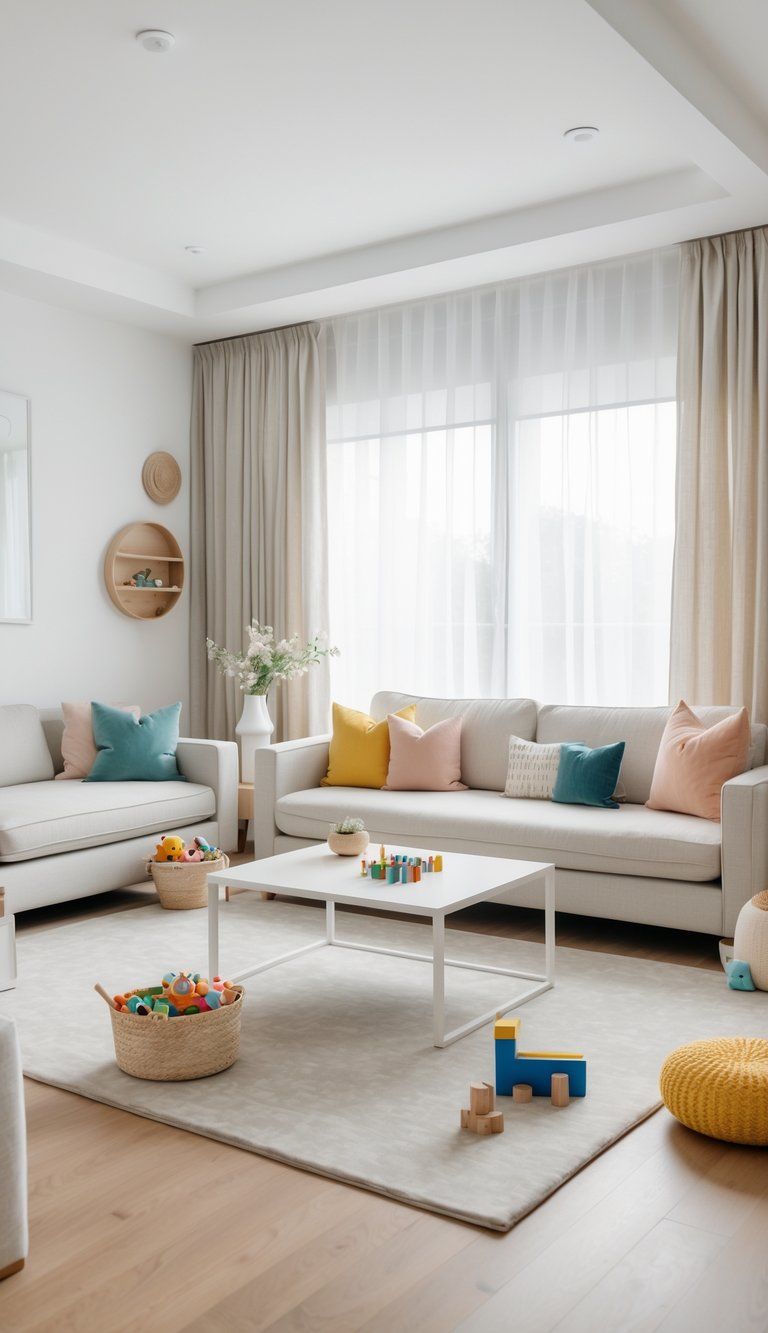
If you want your home to grow with your family, you’ve got to think ahead with your design choices. The right mix keeps things working now, but also makes it easy to adapt when life changes.
Design Choices That Evolve With the Family
Start with neutral basics—sofas, tables, storage—in classic shapes and timeless materials. These pieces become a flexible backdrop for whatever comes next.
Pick modular furniture you can rearrange as your needs shift. A sectional sofa can break into smaller seats, and adjustable shelves grow as you need more storage.
Design spaces that adapt. A playroom with built-ins can become a homework spot, then a hangout for teens, and maybe even a home office one day.
Accessories and textiles update your look without major projects. Swap out pillows, art, or lamps for a refresh instead of replacing big pieces.
Investing in Quality Over Quantity
Go for fewer, better things that last. A sturdy, stain-resistant sofa costs more up front but outlasts several cheap ones.
Multi-functional pieces earn their keep. A solid dining table can handle crafts, homework, and parties—worth every penny.
Look for materials that age well. Natural woods get more character over time, and quality leather actually looks better with use. These pieces tell your family’s story as they wear in.
Stick with classic designs instead of chasing trends. Simple, well-made furniture always looks good, while trendy stuff can feel dated fast.
Think about upkeep, too. Kid-friendly doesn’t mean disposable—washable slipcovers and tough finishes help quality pieces survive family life.
Sustainable and Healthy Materials in Family Spaces
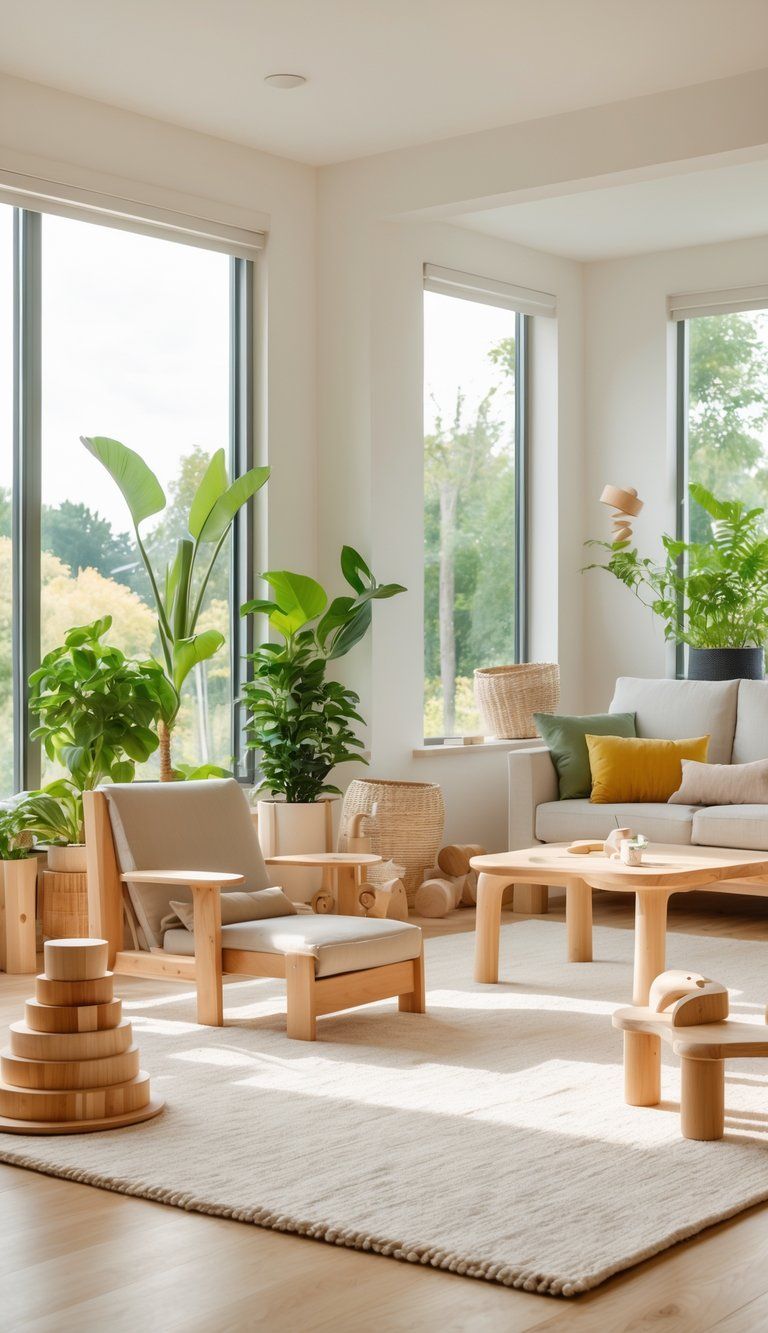
Filling your family spaces with sustainable materials protects your kids and the planet. You can make safe choices without giving up on style.
Non-Toxic and Eco-Friendly Options
When you design for kids, pick materials that skip the harsh chemicals and VOCs. Zero-VOC paints—like Benjamin Moore Natura or Sherwin-Williams Harmony—let you skip the fumes and still get great color.
For flooring, try:
- Cork—it’s soft and naturally antimicrobial
- Bamboo—grows fast and is tougher than oak
- Natural linoleum—made from linseed oil and pine rosin
- Wool carpet—fire-resistant and chemical-free
Pick solid wood furniture instead of particle board to avoid formaldehyde. Look for Forest Stewardship Council (FSC) certification to make sure your wood is responsibly sourced.
Choose window treatments in organic cotton, hemp, or linen. These are healthier than synthetics with flame retardants, and they look great, too.
Easy-to-Maintain Surfaces
Let’s face it—kids are messy, and life just runs smoother with surfaces that can handle it. Quartz countertops shrug off stains and don’t need sealing, which is a relief compared to marble or granite.
You can set out art supplies, prep dinner, or even let a science experiment happen right on the counter without worrying about damage.
For walls, try these ideas:
- Washable matte paint—It cleans up easily and doesn’t have that shiny look some paints do.
- Grasscloth wallpaper—Natural fibers help hide fingerprints, which is honestly a lifesaver.
- Magnetic paint—Turns any wall into a display spot, and you don’t have to poke holes everywhere.
Fabric choices really matter too. Performance textiles like Crypton or Sunbrella stand up to stains and you don’t need harsh chemicals to clean them.
Usually, just a little mild soap and water does the trick.
Sealed concrete floors paired with area rugs make a lot of sense. Concrete stands up to rough treatment, while rugs bring in warmth and can be swapped out or cleaned when needed.

